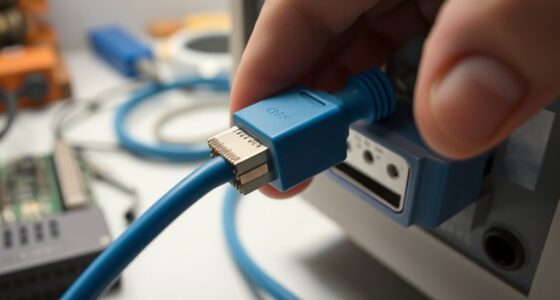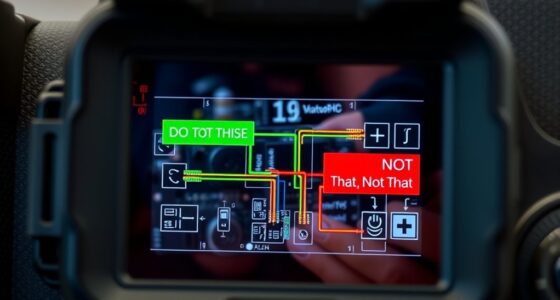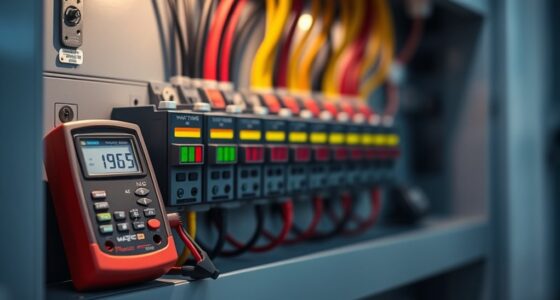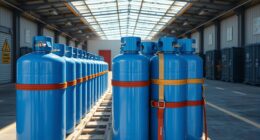Understanding whether a 30 amp or 50 amp RV connection works best depends on your RV’s power needs. A 30 amp supplies up to 3,600 watts, suitable for smaller RVs with basic appliances, while a 50 amp offers more power for larger setups and multiple devices. Proper compatibility, wiring, and safety checks are essential to avoid overloads. For a detailed comparison and tips on choosing the right connection, continue exploring these field notes.
Key Takeaways
- 30 amp supplies up to 3,600 watts, suitable for basic RV needs, while 50 amp offers around 12,000 watts for larger appliances.
- Proper wiring, grounding, and safety checks are essential, especially for 50 amp connections due to higher power demands.
- 50 amp hookups support multiple high-energy devices simultaneously, enhancing RV comfort and future upgrade potential.
- Compatibility with RV appliances, generator capacity, and outlet types is crucial for safe and efficient power use.
- Regular inspection of cords, outlets, and circuit breakers helps prevent overloads and electrical issues during RV operation.
Understanding the Basic Differences Between 30 Amp and 50 Amp Power Supplies
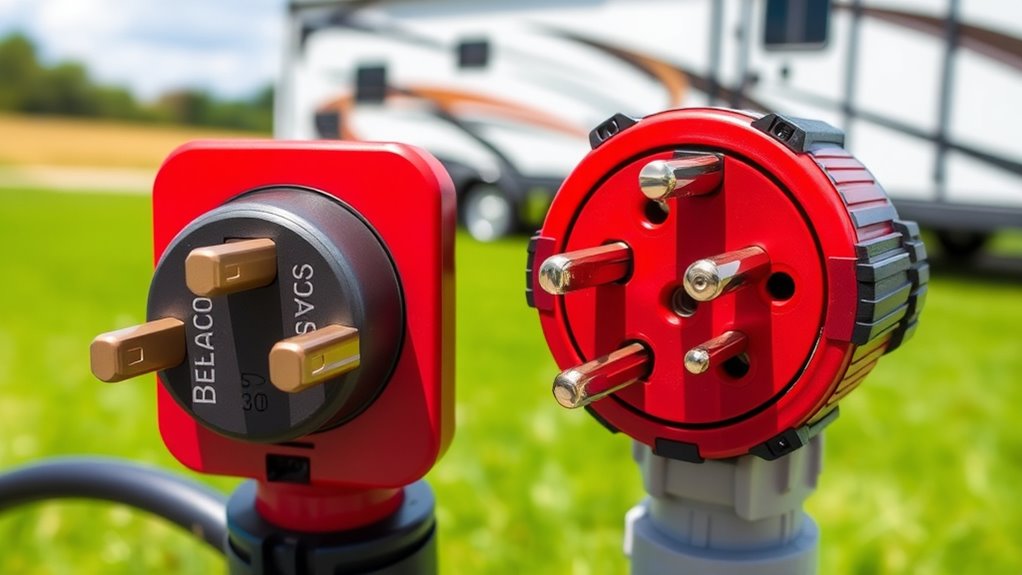
Although both 30 amp and 50 amp power supplies provide electricity for RVs, they differ markedly in capacity and design. The 30 amp system supplies up to 3,600 watts, while the 50 amp system offers around 12,000 watts, making it suitable for larger RVs with more appliances. When considering electrical safety, a 50 amp connection requires proper wiring and grounding to prevent hazards. Energy efficiency also plays a role; using the right power supply guarantees you don’t waste electricity or strain your RV’s electrical system. Understanding these differences helps you choose the appropriate connection, reducing risks and optimizing power usage. Being aware of capacity and safety considerations guarantees your RV experience remains smooth and secure, whether you’re plugged into a 30 or 50 amp outlet. Additionally, understanding the electric load capacity of your RV’s electrical system ensures you do not overload circuits or cause potential damage during use.
How Voltage and Current Capacity Impact Your RV Experience
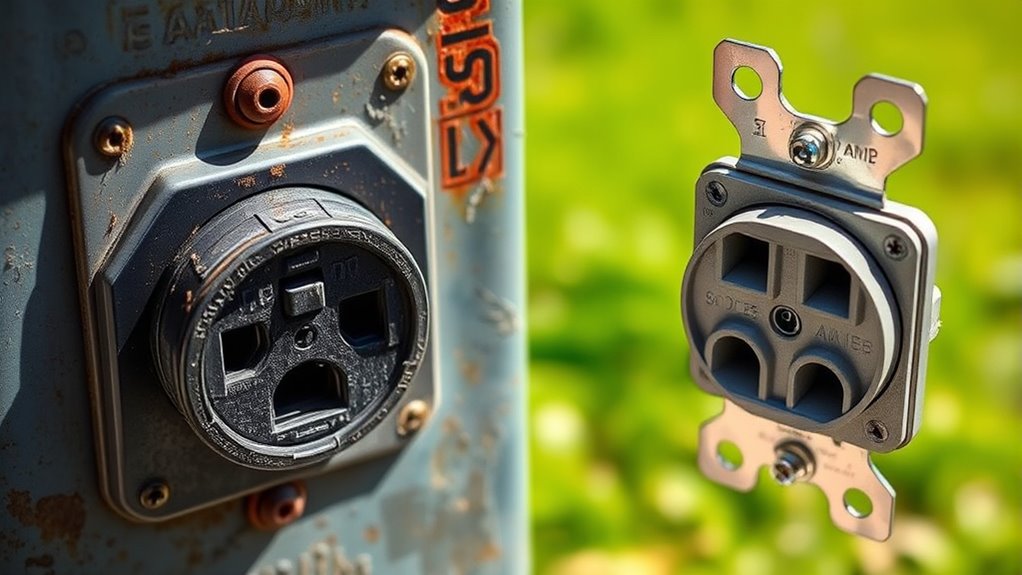
The voltage and current capacity of your RV’s power connection directly influence how well your appliances perform and how safely you operate your setup. Voltage stability guarantees your devices run smoothly without flickering or damage, while adequate current capacity prevents overloads. Insufficient power can cause circuit protection devices to trip, risking inconvenience or appliance harm. Higher capacity connections, like 50 amps, offer more stability and better support for multiple high-power devices simultaneously. Proper understanding of power capacity is crucial for safe and efficient RV operation. Here’s how capacity impacts performance:
| Power Capacity | Voltage Stability | Circuit Protection |
|---|---|---|
| 30 Amp | Moderate | Basic |
| 50 Amp | High | Enhanced |
| Voltage Drop | Potential | Overload risks |
| Appliance Use | Limited | Safer operation |
| Overall Safety | Better with higher | Essential |
Choosing the right capacity guarantees safety and best performance.
Compatibility Considerations for Your RV and Campsite Hookups

Before hooking up, make sure your RV’s power needs match the campsite’s outlets. Check for compatibility in voltage and amperage, and consider using adapters or plugs if necessary. Ensuring these connections are correct prevents damage and keeps your trip running smoothly. Additionally, understanding the Bedroom layout and electrical requirements can help you better plan your campsite setup and avoid potential issues.
Power Compatibility Checks
Ensuring your RV’s electrical system matches the campsite’s hookup is essential for safe and reliable power. Start by checking generator compatibility if you plan to use a backup power source, making sure it supplies the correct voltage and amperage for your RV’s connections. Voltage converters can help if your campsite’s power doesn’t match your RV’s requirements, converting the voltage safely and efficiently. Always verify the voltage and current ratings of your RV’s electrical system and the campsite’s outlet before connecting. This prevents overloads, electrical damage, or safety hazards. Be aware that essential oils can be used to create a calming environment during setup and troubleshooting. By conducting these power compatibility checks, you ensure your setup runs smoothly, protecting both your RV and your loved ones during your camping trip.
Adapter and Plug Options
Choosing the right adapter and plug options is crucial to guarantee your RV can connect safely and effectively to the campsite’s electrical system. Make certain your adapters are compatible with your RV’s amperage, whether 30 or 50 amps, to prevent overloads. Using the correct plug type also minimizes risks and simplifies generator maintenance, as mismatched connections can cause issues down the line. Consider cable length carefully; too long a cable can lead to voltage drops, affecting your RV’s performance. Shorter cables reduce this risk but may limit mobility around the campsite. Always verify that your adapters and plugs meet safety standards and are rated for your specific setup. Properly chosen options ensure reliable power, protect your equipment, and make your camping experience hassle‑free. Additionally, consulting whole‑house water filtration system options can help ensure your water quality remains high during your trip, adding to your overall comfort and safety.
The Pros and Cons of 30 Amp Connections for RV Owners
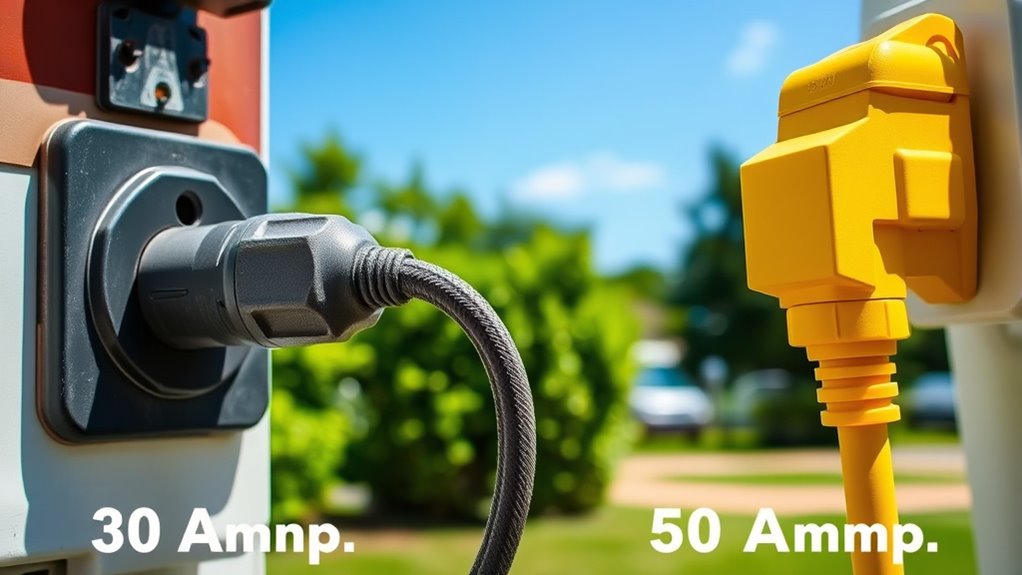
30 Amp connections are generally more affordable and widely compatible with many campsites, making them a practical choice for budget-conscious RV owners. However, they also come with power limitations that can restrict your usage, especially if you have multiple appliances or larger equipment. Understanding these pros and cons helps you decide if a 30 Amp hookup fits your camping style and needs. Additionally, being aware of gaslighting tactics can help you navigate potential issues with power and safety during your trips.
Cost and Compatibility
While 30 amp connections are generally more affordable upfront, they can limit your RV’s electrical capabilities and future compatibility. You might save money initially, but you could face challenges with electrical safety and power conversion when upgrading or adding devices. The smaller capacity means fewer options for appliances and tools, potentially causing inconvenience or safety risks. Compatibility with newer RV models or accessories may also become an issue, forcing you to replace outlets or adapters later. Consider this table to weigh your options:
| Factor | 30 Amp Pros | 30 Amp Cons | Impact on You |
|---|---|---|---|
| Cost | Lower initial price | Limited future use | Budget-friendly now, costly later |
| Compatibility | Fits many older setups | Not compatible with 50A RVs | Restricts upgrades |
| Electrical safety | Adequate for small loads | Overloading risk if misused | Safety depends on proper use |
| Power conversion | Simple and straightforward | Less power for large appliances | Limits flexibility |
| Future readiness | Good for basic needs | Not future-proof | May need upgrades later |
Power Limitations and Usage
Understanding the power limitations of a 30 amp connection helps you determine whether it meets your RV’s needs. A 30 amp hookup provides up to 3,600 watts, which is enough for basic appliances and lighting but may strain when running multiple high-wattage devices simultaneously. You’ll need to prioritize your power usage to avoid overloads. Regular generator maintenance is essential if you rely on a generator as backup; neglecting it can lead to inconsistent power supply. Additionally, ensure your RV’s electrical system complies with electrical code standards to prevent hazards. If you plan longer stays or use multiple appliances, a 50 amp connection might be more suitable. Knowing these limitations helps you optimize your power usage while maintaining safety and efficiency. Recognizing the signs of electrical overload can help prevent damage to your RV’s system and ensure safe operation.
The Advantages and Limitations of 50 Amp Hookups
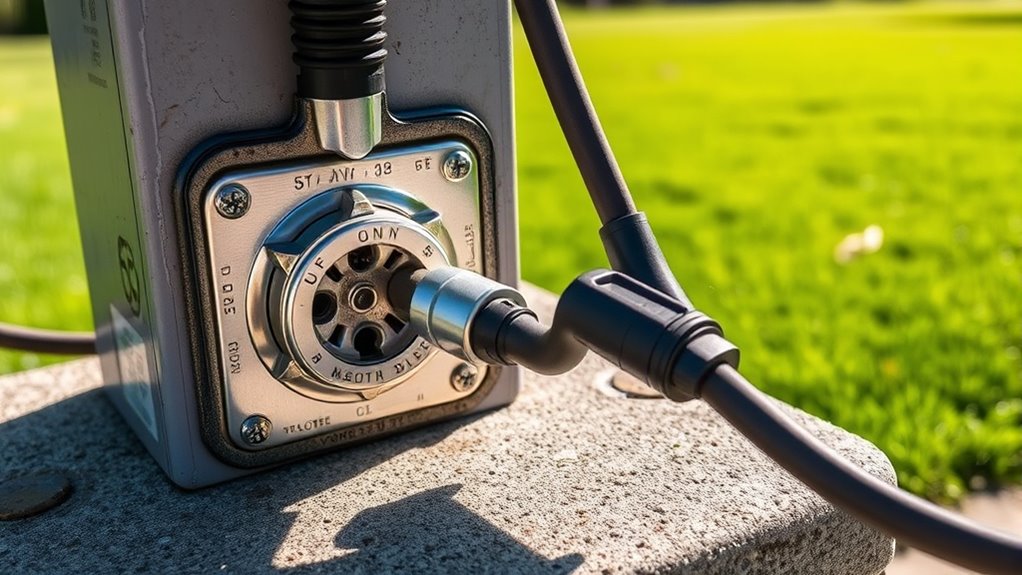
A 50 Amp hookup offers significant advantages for RV owners who need more power, especially when running multiple appliances or high-energy devices simultaneously. It provides ample capacity for larger appliances, air conditioning units, and advanced electronics, making your stay more comfortable. However, there are limitations to contemplate. You must ensure electrical safety by using proper wiring and connections to prevent overloads. Compatibility with your generator is essential, as not all generators can handle 50 Amp hookups efficiently. Additionally, the increased power demand can lead to higher energy costs. Installing a 50 Amp connection requires more robust wiring and a compatible outlet, which could increase setup complexity. Ultimately, while offering more power, it demands careful attention to safety and electrical safety practices to maximize its benefits.
Practical Tips for Selecting the Right Power Connection for Your RV

Choosing the right power connection for your RV starts with evaluating your energy needs and usage habits. If you plan to rely on solar power, a 30-amp connection might suffice for minimal appliances and charging needs. However, if you want more flexibility for appliances or future upgrades, a 50-amp hookup provides extra capacity. Consider if you’ll use a generator hookup regularly; larger connections handle higher power demands better. Think about your typical camping setup—if you’re boondocking or off-grid, solar power combined with a suitable connection is vital. Also, check your RV’s electrical system and manufacturer recommendations. Matching your power connection to your energy consumption guarantees safe, efficient operation, prevents overloads, and maximizes your RV’s capabilities. Understanding electrical system compatibility ensures you select the most appropriate and safe power connection for your specific RV model.
Common Issues and Troubleshooting Tips for RV Power Connections

Power connection issues can disrupt your RV experience unexpectedly, but many problems are straightforward to identify and fix. Common issues include loose connections, faulty wiring, or damaged outlets. Start by checking your generator maintenance routines to ensure everything runs smoothly. Always use surge protection to prevent electrical surges from damaging your system. Here are some troubleshooting tips:
- Inspect power cords and outlets for visible damage or corrosion
- Tighten loose connections in the power pedestal or cord
- Test the circuit breaker or GFCI for tripping or faults
- Verify that your surge protector is functioning correctly and not faulty
- Regularly review electric power generation systems to ensure optimal performance and prevent potential issues
Addressing these issues promptly can save you from more extensive repairs and keep your RV power running reliably.
Frequently Asked Questions
Can I Convert a 30 Amp Outlet to 50 Amp?
You can’t directly convert a 30 amp outlet to 50 amp without an adapter and breaker upgrade. To do this safely, you need a compatible 50 amp adapter and a professional electrician to upgrade your breaker panel. This ensures proper voltage and current handling, preventing damage or hazards. Always prioritize safety and consult a professional to handle any modifications involving electrical systems, especially when upgrading RV connections.
Are There Safety Risks Switching Between 30 and 50 Amp Connections?
Switching between 30 and 50 amp connections is like walking a tightrope—you must be cautious. Yes, there are safety risks if you don’t prioritize grounding safety and guarantee amperage compatibility. Using improper adapters or mismatched outlets can cause electrical shocks or damage your RV’s system. Always check that your equipment matches the outlet’s amperage, and verify grounding safety to prevent potential hazards when switching connections.
What Tools Are Needed to Upgrade My Rv’s Power Connection?
To upgrade your RV’s power connection, you’ll need a new power outlet compatible with the desired amperage, a wiring upgrade kit, a voltage tester, a screwdriver, wire strippers, and possibly a circuit breaker. Turn off the power, carefully disconnect the old outlet, and install the new one with upgraded wiring to handle higher capacity safely. Always follow safety guidelines and consider consulting a professional if you’re unsure.
How Do I Identify if My RV Is Compatible With 50 Amp Hookups?
You can identify if your RV is compatible with 50 amp hookups by checking its power requirements and outlet compatibility. Look at your RV’s power cord; a 50 amp outlet has four prongs, with the two hot wires, neutral, and ground. Your RV’s electrical panel will also specify if it requires a 50 amp connection. If you’re unsure, consult your owner’s manual or have a professional inspect your setup.
Is It Cost-Effective to Upgrade From 30 Amp to 50 Amp?
Upgrading from 30 to 50 amps can be cost-effective if you frequently run high-power appliances or plan longer stays. The initial cost comparison shows installation costs range from $300 to $1,000, depending on your setup. While the upgrade requires an investment, it can save you time and hassle, especially when using multiple appliances simultaneously. If your RV needs grow, the upgrade pays off in convenience and capacity.
Conclusion
Choosing between 30 amp and 50 amp hookups depends on your RV’s needs. Did you know that over 60% of new RVs now come equipped for 50 amp service? Whether you’re camping solo or with a group, understanding these options guarantees a safer, more efficient experience. Make certain to match your RV’s power requirements with the campsite hookup to avoid issues and keep your adventures running smoothly.



